I was waiting in line to buy a movie ticket when I heard the news: Jani Leinonen had been incarcerated. Conversations with my Finnish friends in the previous weeks had been gripped with anxiety over the fate of a kidnapped Ronald McDonald figurine from a McDonald’s restaurant in Helsinki. A series of YouTube videos chronicled the antics of the activist group, the Food Liberation Army: beginning with the abduction of a Ronald McDonald statue on January 31, the delivery of eight demands to the McDonald’s corporation to divulge unsavory secrets of their food production processes (see video below), an invitation proffered to McDonald’s employees to speak out, and lastly the grim execution of Ronald McDonald on Friday, February 11, 2011.
[youtube:https://www.youtube.com/watch?v=wcBuRSzCbM8]
Nearly two weeks following Ronald’s guillotine-style beheading, Leinonen agreed to recount his recent stay in the big house with me. I had imagined that the artist Jani Leinonen would match the bombastic hype of the events reported in the recent media flurry. Parallels were drawn–I hoped with hyperbole–between the Food Liberation Army and terrorist groups such as al-Qaeda. I prepared myself to face a brash and dangerous character. Truthfully, I was afraid—I don’t make it a habit of lunching with potential terrorists.
My fears were allayed within minutes. It was immediately apparent that the artist and the affable person across the table in a red woven hat with white snowflakes overlap in name only. As we talked, Leinonen picked at a smudge of white paint on his right hand, a gesture that removed the last vestiges of the artist from the conversation. Though the artist might dabble in petty theft and vandalism, Jani, the ordinary person, enjoys snowboarding and strawberry milkshakes. My erroneous preconceptions of Leinonen disintegrated as he explained a belief in the artist’s responsibility to mediate social and civil injustices.
A contemporary artist such as Leinonen is a cultivated spokesperson; the artist is merely a mouthpiece for the cause or agenda that fuels the work. In graduate school in the United States, it cynically occurred to me that self-promotion can sometimes be an indispensable stratagem for success; cleverly, it can be dissolved into the conceptual thrust of one’s artistic output. In Finland, however, those who willingly bask in the limelight are often reproached for immodesty. Far from an exception to the rule, international coverage of Leinonen’s mock terrorism landed him in jail.
Born in 1978, Leinonen represented Finland in the Nordic & Danish Pavilion during the 2009 Venice Biennale, seven years after his graduation from the Academy of Fine Arts in Helsinki. For this exhibition, Leinonen amassed handmade signs from street beggars from numerous countries displaying a synonymous plea for compassion. In the recent project linked to the Food Liberation Army, Leinonen employs and simultaneously holds hostage the marketing structures of corporate giants like McDonald’s, in addition to the celebrity culture perpetuated by the media. Leinonen’s paintings, installations, performances, sculptures, and videos liberally borrow from the colorful language of advertising to comment on production—both the literal systems of food processing and the immaterial residue of cultural producers.
The following interview took place at Ravintola Nolla in Helsinki on February 22, 2011.
Jacquelyn A. Gleisner: Is that your real name, Jani Leinonen? It sounds like John Lennon to me.
Jani Leinonen: Like a Finnish version? I never thought of it that way, but I guess if you say it quickly. My best friend Riiko and I have this competition to see whose name gets twisted more by foreigners. His full name is Riiko Sakkinen. In Japan it was once spelled Ricco Sannen. My best one was in Pittsburgh–Yanni Leinn.
JAG: And your friend Riiko, is he also part of the Food Liberation Army?
JL: Actually, no. He wanted to be a part of it, but I never told him about it. The whole thing was supposed to be a big secret. Then stuff happened.
JAG: Meaning you were arrested?
JL: Yes, and everyone found out that I was responsible.
JAG: Were there any doubts that you were responsible?
JL: Yeah, because we tried to make it as anonymous as possible. Art is such a fictional way of communicating that people don’t really take it seriously. There are only a handful of people that actually go to galleries and then think the things through that they see. There is a problem of context and also the tag of art. I wanted to make Ronald’s kidnapping look real for as long as possible. There were no names. My plan was to display the whole spectacle in an exhibition a few months from the actual event. Sometimes things don’t really work out the way you plan them. Once my name came out, people thought, “Oh, this was art.” And that neutralized the work.
JAG: Has the McDonald’s corporation responded to any of the questions from the YouTube video?
JL: Well, through the media they have responded to the reporters’ questions, but they were vague.
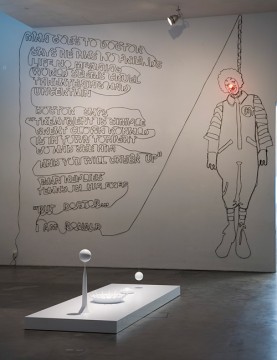
Jani Leinonen, installation shot from the show "On the Right Track," Kiasma Museum of Contemporary Art, 2009. Courtesy the artist.
JAG: Is it true that you’re quite a big fan of McDonald’s?
JL: Well, yeah. I go there a lot. I am ashamed of it, but I do. Many of friends here are in the food business. They are trying to make a little revolution by choosing not only organic, but more local, ethical, and non-industrial food products. Some of my friends own an organic grocery store and they have been experiencing the problems in the food industry in the shop. Consumers want cheap food and they think that things have to be done in a certain way. It’s been interesting to follow as an outsider.
These issues are especially important because there is a problem with freedom of speech. People in positions like advertising can’t say the things that they want to say out loud. They’re afraid that the money they are making for their company will go away. Money has shut their mouths. Their position in politics or something else makes them really scared to be involved in anything as radical as stealing a plastic store decoration. I don’t have clients that have demands or contracts with advertisers I have to please. Most people are tied to the place where they get their money. Artists have freedom of speech and a responsibility of speaking.
JAG: Do you more feel hesitant now in light of recent events to speak your mind in future projects?
JL: Yeah, I guess. We never were trying to hide from the police because I thought that they would never bother. They could have just made one phone call and found out that it’s me. We did cover our tracks from the reporters because we needed anonymity. The police incident was very dramatic. There were six cops with search warrants at my studio. They cuffed me and threw me into jail for thirty hours. I thought I was just stealing a store decoration, but I must have done something much worse.
JAG: What happened when you were in jail?
JL: They detained me for twenty-eight hours. I thought that I had made a fictional piece and we were acting like terrorists. All of the images that we used in this project I have used in other media like in my paintings; this was just a different venue. When we put it on the internet, suddenly it became real. I guess the police acted like bad cops after we acted like the bad guys.
When they came to my house, they really roughed me up. And I thought, shit—I have never been to jail! Afterwards my janitor who opened the door for the police said that they were laughing. They were saying that they have never had so much fun, but I was scared as hell. I was thinking, “What the fuck did I do? Did I do something more serious that I didn’t even think of?”
JAG: In the future, are you interested in continuing the cause of exposing the processes of food production in large corporations such as McDonald’s?
JL: I don’t really know if this revealed anything. The initial aim was that the reporters would start asking the questions from McDonald’s. We wanted to hand the reporters a really nice package of information and then they would turn to McDonald’s to ask the questions. Instead, the reporters called the police. I guess it was a failure in that sense. Discussions have started in the media about the food industry, perhaps not directly related to this. Most of my artistic production is about food products, playing with the symbols and the advertising that are used.
JAG: Do your paintings involving pornographic images of women also relate to the food industry or the idea of consumption?
JL: Yeah, actually in most of those pornographic works the clothes that are painted on the women are from food advertisements like ice cream packages, for example. There are maybe ten works that are from high fashion, but most of the porn works are actually from the food industry.
I don’t think that I can stay outside the system. I want to engage with society and create a spectacle. Then the chain of events and the reaction reveals something about the whole of the society and how it works. There’s no way to predict the outcome. I was sure that we would be in the news in Finland, but I never thought I would go to jail. I can laugh about it now, but I wasn’t laughing when I was being thrown in jail.
JAG: Do you regret doing the last project at all?
JL: No. Of course I said that I regret it during the interrogations. I guess that I did have regrets when I was almost crying in the dark cellar. I told them everything. I thought that I was making another piece of fiction, but somehow it was real. There was no harm done to anybody and I thought we might be actually making people laugh. There was no damage done to any property. The statue is actually there now—we brought Ronald back. It was all very innocent. When you look at it from that perspective, it’s crazy what happened. Now we’ve received so many e-mails from regular people and from people working at McDonald’s. If the piece was originally presented as art, I don’t think that the reception would have been the same.
JAG: So this is not the end for the Food Liberation Army?
JL: No, definitely not. I have many plans.
JAG: Can you talk about how your philosophy regarding socially interactive work started? Can you begin with your experiences as a student here in Helsinki?
JL: I can tell you the history of all my art schools. When I was seven, my mom took me to an art school for children. When I asked her why she took me there, she said that I wanted to go there. She would have never thought of taking me there. I had brilliant teachers there. The best teacher was not an art teacher but a Finnish teacher. She was very Duchampian—she thought that everything was art. She wasn’t just talking about paintings. She talked about literature and how it has affected the politics of the world. She was drawing a huge picture of the world in Finnish class. Then, I was accepted to the Academy during the second grade of high school. I finished the high school in three years and went directly to the Academy. That took five years. I did my civil service in the Academy which was one and a half years. And then I stayed there for two years as an assistant. After that I thought maybe my time in art school is done.
JAG: What was your work like at the Academy of Fine Art?
JL: Very confused. I have been painting since I was a kid, but the puberty of the painting hit me when I was at the academy. Even though I was in the painting department at the academy, I barely painted. I was conceptually challenging the teachers and asking, “Why is this good art, why is this bad art?” Finland’s most famous artist was Juhani Palmu back then. He painted landscapes and he sold a shitload of work. Of course, my professors hated him. I thought that it was such an unjustified hate. It was just landscape painting—it wasn’t really that bad.
There were dozens of artists of the same quality, but the teachers weren’t talking about the others artists at all. It was because this guy was in the media all the time. He was like the rap star of Finnish art back then—he wore lots of gold and had lots of rings and of course, very tacky suits. For me it was very interesting that the professors were only talking about his art. They actually hated him because of his media appearance, not his art.
I decided that I wanted to get to know this guy. I walked into his gallery and I said, “I am from the art school and do you have a summer job for me?” When I worked there over the summer, I got to know him. Everybody was outraged that I went to work for this guy that everybody hated.
Later I used his work as readymades. I took his works as my own to shows to piss people off. It wasn’t about the art. They were using the art, talking through the art about something else—about values and about systems of valuing art. I wanted to make that transparent. I wanted to make them realize that it’s not the art that is actually the issue here but something else.
The whole study process for me was about questioning what’s going on with the media and the art world—opening it up for myself and asking really stupid questions. The professors had all these contradictions about what good art is. They were moralists, especially in the painting department at that time. It really pissed me off. Eventually I became be good friends with many of the professors, but at first I questioned everything.
JAG: Do you have any interest in teaching yourself?
JL: Yeah, I have been teaching some courses and I give lectures all the time. It’s fun— I like it. I haven’t found the right way to combine doing my own art and teaching. Especially lectures, I really stress over them a lot. I would rather hire an actor to do all my lectures because I don’t really enjoy it. I have hired actors in the past to speak for me. Actually the head terrorist in the video is a talented actor who has done a few speeches for me.
One speech was for the board of the University of Helsinki. I was invited me to give a talk at Finland’s Independence Day Gala. There were maybe six hundred people in tuxedos attending the event. I was filming the whole thing with a camera from a balcony. Finally this actor got to the stage. The speech began by talking about the identity of a citizen. What is my national identity and what does it really mean to be a part of a nation? It’s such a huge entity but it is complete fiction—it’s a fictional community. It can’t be a real community because people don’t really know each other. Two thousand miles up north, there are Finns that I have nothing in common with. Still we are in this weird community together.
So, he starts doubting the whole idea of this national identity—perhaps it is not real. He goes on to talk about his own identity. What is really real in my own identity? Most of our identities are created, maybe even our sexuality. It got deeper and deeper and then finally, he said, “Who am I? Am I Jani Leinonen? Maybe you are? Or maybe it’s that guy over there filming the whole thing?” Then suddenly, all six-hundred people turn to my direction, and I waved.
JAG: What are some examples of lectures that you have given in the past?
JL: A long time ago I had this very nice, very business-like PowerPoint presentation. People wanted me to talk about my art but instead, I talked about this company called “Jani Leinonen.” I wore a suit and the presentation showed how the company will grow and what product lines we have. For example, we had uniques and we had mass-productions. I had marketing key chains and leaflets. When I distributed them to the people, they said, “What the fuck is this?” I did it in such a dry, credible manner that everyone thought it was real. It was very interesting because the people were so excited to ask me questions.
Mostly people want to hear me talk about my art and many people from the universities and art schools ask me to talk about artist branding. Suddenly, I am forced to talk about how to market your career as an artist, like what do you do when you are an artist other than paint paintings.
JAG: Has the notion of branding been something that you’ve emphasized in your own career?
JL: No, not really. Maybe I have unconsciously. This alter ego that has the name as me is a fictional character. I use him to bring out things. He’s not really me. I have my real life and a family—these things have nothing to do with the artist. Since I have been thinking through this fictional character so much, it is actually easy to talk from his perspective.
As a student, I wanted to get to know the art world very well. I was studying it—checking out how things are done. I made up projects that were socially involving. One project was a National Championship of Art which was a wrestling tournament that I invited artists to. The artists wore these huge Sumo suits and they wrestled. The judges were the authorities of the art world—art critics, museum directors, art historians, gallerists—all the most important people in Finland’s art community.
JAG: And who won?
JL: Aurora Reinhard. She’s a Finnish artist. The judges weren’t evaluating the wrestling. They were evaluating the artists based on artistic match or game, even though the artists truly did wrestle. I called Kiasma and asked if they would be interested in hosting this project for one night at its theater. And they said yes. I thought it was more interesting to learn by experience rather than reading about theory. Nobody taught that in school—nobody was talking about the social structures of the art world. They said, “Paint!” And that was that. For me, art has never been about painting only. It is a whole world.
JAG: Is there a hierarchy between painting and your other projects–like the more socially engaging works?
JL: No, I do so many different things. This Ronald thing came out of a certain frustration that I felt. I can’t do certain things with paintings or sculptures—they are just not working. They are not telling the story and people are not taking them seriously. I don’t think painting is dead. There is still an audience for painting, but I wanted to talk to a different audience. People have bizarre expectations and ideas about contemporary art.
JAG: What contemporary art do you like?
JL: Superflex is one of my favorites. Also, my friend Riiko Sakkinen has probably influenced me more than anybody from art history. There’s a French artist called Matthieu Laurette. Most of his work is about kind of system of commodity or exchange. One interesting work of his involved the talk show Good Morning America. There are always people outside the studio waving their signs. And he had this one big sign there that said “I love Debord.” The installation for the show of this piece was the video of his sign and a huge wall of these signs he collected from other people with greetings to Mommy and Poppy. He removed these elements from reality, added his input, and then he displayed the whole thing. It became something very revealing.
JAG: And you had a similar project in which you purchased signs from beggars?
JL: I started buying the signs from beggars six years ago in Texas for one show but since then I have continued. There were twenty-seven signs from eleven different countries in my show at the Venice Biennale but the messages are really all the same.
JAG: And in terms of more art historical influences?
JL: I do love Duchamp, but most of his works are really boring visually. Conceptually, he is amazing. My job is not to determine what will be interpreted from the work. I like to leave the works open so there are many possible interpretations. I am trying to change the meaning of the characters or images that have been given something specific. We kidnapped Ronald McDonald, but it was more about kidnapping the brand.
This idea comes from Duchamp like what he did with the urinal. I guess that in a way Ronald is a urinal. Duchamp changed the context of the urinal and that’s all we did too. I am interested in art but I don’t think that art is the most important thing in the world. That’s why I want to talk about other things, not just about art. Duchamp was focusing on the art world mostly, but there are deeper meanings about the vagueness of meaning in his work—about propaganda and controlling ideas and owning ideas and copyright. He was doing things that still have meaning today.
In addition to Duchamp, Martin Kippenberger is one of my biggest inspirations. If Warhol was making pop art from the top ten brands like the very nicely designed Coca-Colas and Brillo pads, Kippenberger was the poor man’s Warhol. He used tacky and crappy and cheap labels to make his art. I love Warhol, too. I don’t know how to define my art, but I guess it’s like political pop art. I think what I would add to Warhol’s art is the politics. He did have some political views, but of course he was trying to be the mirror of society and not really take a stand about anything. But Kippenberger was making extremely interesting statements through his art.
JAG: And he also worked with clown imagery?
JL: Yeah, I think that artists are clowns. In the King’s court, the joker was the only one that could laugh at the king. Sometimes the clowns were also executed, but nobody could make jokes about the people in power except the Joker. He’s an interesting character because he’s crying and smiling at the same time—like Ronald. He has tears streaming from his eyes but still there’s this huge smile. It’s fascinating that McDonald’s uses this symbol. Most of these characters in the commercial world are billed to be very flat and controlled. They don’t do much. They don’t have backgrounds and they are not robust. But when I see a character like Ronald, I start thinking about what he does when he gets off work and out of the advertisement. For me that’s inspirational— we are human and so are these characters. We all have flaws and we have our dark bedrooms secrets.
JAG: So what does Ronald do, for example, when he’s not working?
JL: He’s such a superstar, but he’s looking for happiness. He’s bigger than Jesus. Who can help him? And now he got involved in this kidnapping thing. It was not his fault.
JAG: Were you liberating him in a way?
JL: Yeah, he was smiling the whole time.
JAG: Until you decapitated him?
JL: He was still smiling. He’s still smiling now, even after the decapitation.
JAG: What’s next for you?
JL: I’m making a movie. Ronald saves the world. He becomes a hero.
JAG: Lastly, what do you eat when you go to McDonald’s?
JL: A quarter-pounder with fries and a small strawberry milkshake.
###
*McDonalds deemed the act to be in “poor taste” in their official statement: “McDonald’s is always available to engage in constructive conversations with our customers, stakeholders and the media. This stunt is in very poor taste and not a responsible approach to meaningful dialog.”
A version of the above text was published in the book Jani Leinonen: Funeral Notice.
Leinonen’s current show, “Finnish activist encounters the cosmopolitan upper classes” is at Galerie Gmurzynska in Zurich, Switzerland until June 4, 2011.

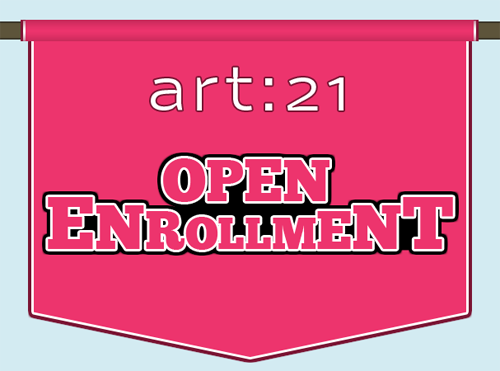
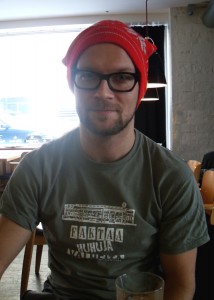
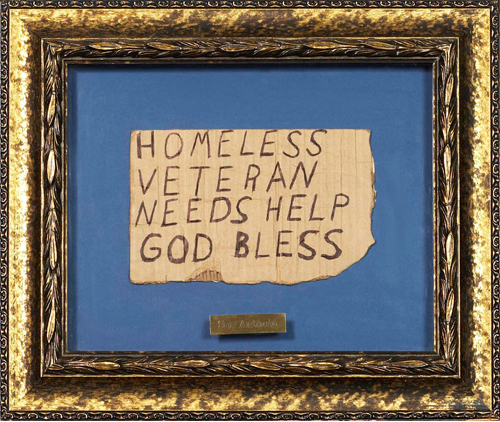
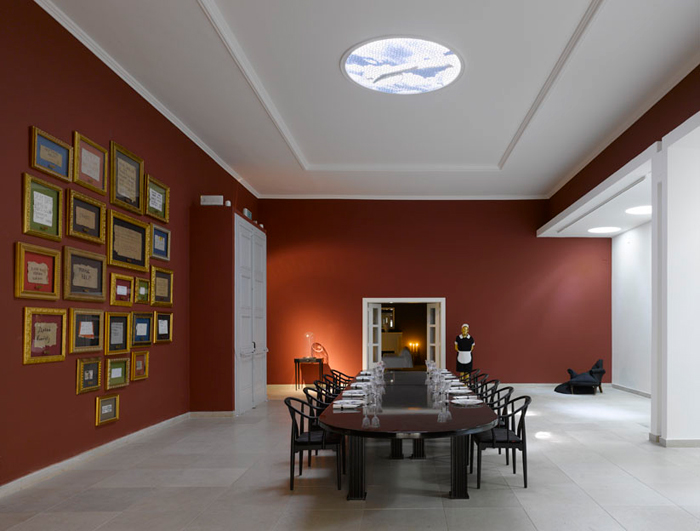
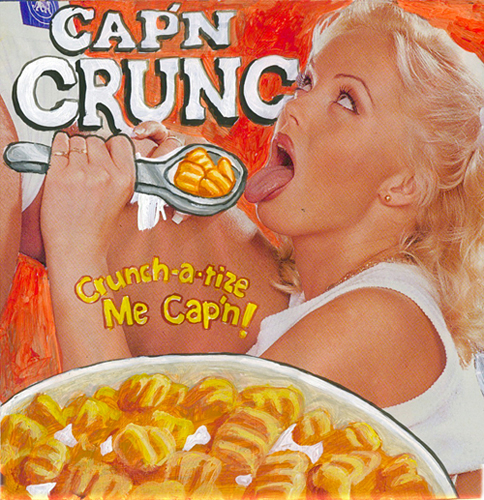

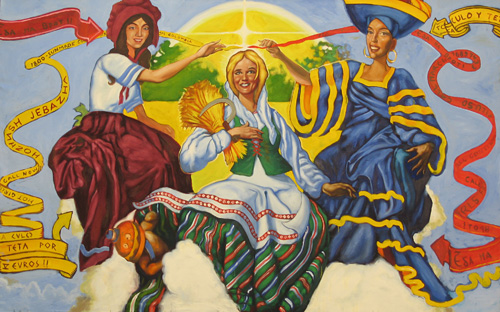



Pingback: City in fast-forward, Kivinokka at leisure | Africans in Finland